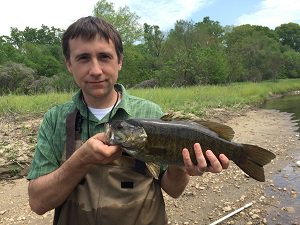
COG Environmental Planner Aubin Maynard
Except for a glimpse of water flowing under the Woodrow Wilson Bridge, the drive along the Capital Beltway can feel pretty landlocked. Drivers might not realize that as they cruise along some of the region’s largest roads, they actually traverse many of the tributaries that feed the Anacostia River – our Region’s second great river.
Thanks to the work of the Anacostia Watershed Citizens Advisory Committee (AWCAC) and the guidance of COG Environmental Planner Aubin Maynard, there are now signs in these areas identifying watersheds and tributaries. This project is ongoing, with AWCAC, the Maryland-National Capital Park and Planning Commission, Prince George’s County, Montgomery County, and the National Park Service now collaborating on signage for the new Riverwalk Trail, as well as watershed-wide trails in Prince George’s and Montgomery Counties.
“These signs help to pull people back to the Anacostia,” explains Maynard. “They create awareness, reminding people that the Anacostia is a good river. It’s being cleaned up. People care about it.”
Maynard has always loved water. What began as an interest in water activities like swimming and fishing led to a master’s degree in Water Resources Management. He served in the Peace Corps in Guatemala, has worked on environmental education issues in Japan, and for the last six years has been with COG working alongside citizens who recognize that the Anacostia River is affected by an area much larger than its boundaries.
On a normal day, Maynard gets to the office early; he changes into old clothes, dons his waders, and heads back out to a local stream like Nash Run to perform water quality analysis or a fish survey. Back at COG, he dives into analyzing GIS data or lends his expertise to meetings of the Anacostia Watershed Restoration Partnership, a regional effort supported by the District of Columbia, Montgomery and Prince George’s Counties, state and federal partners, and led by COG to coordinate the restoration and protection of the river. In the evenings and on weekends, Maynard joins AWCAC—the citizens’ arm of the Partnership—or one of the many community-based watershed groups like Friends of Sligo Creek or recently-formed Friends of Dueling Creek for meetings and events. These groups are made up of homeowners, activists, and even retirees.
Most often, Maynard aids the volunteer groups by coordinating guest speakers to discuss the river’s health, or provides detailed information about the river to aid with a group’s specific outreach efforts. For those in the Greenbelt area, that might involve working to remove invasive species from near their creeks. For those in the District of Columbia’s Wards 7 and 8, that could mean finding ways to better connect the community to the River.
“We also share news about the Partnership and hear citizens’ concerns,” said Maynard. “We bring their feedback back to the greater Partnership and work to fold their ideas into the greater work that COG is doing.”
Recently, Maynard helped with the Earthday Anacostia-wide cleanup. In addition to providing information to cleanup participants, Aubin and his colleagues caught live fish and put them in tanks for kids and other participants to experience.
“We were able to demonstrate that there’s a lot of life out there and good things going on in their river,” said Maynard.
Maynard says that in addition to getting to do field work, he finds working with the local watershed groups the most rewarding part of the job.
“They’re not getting paid—they’re doing it because they believe in this cause,” said Maynard.